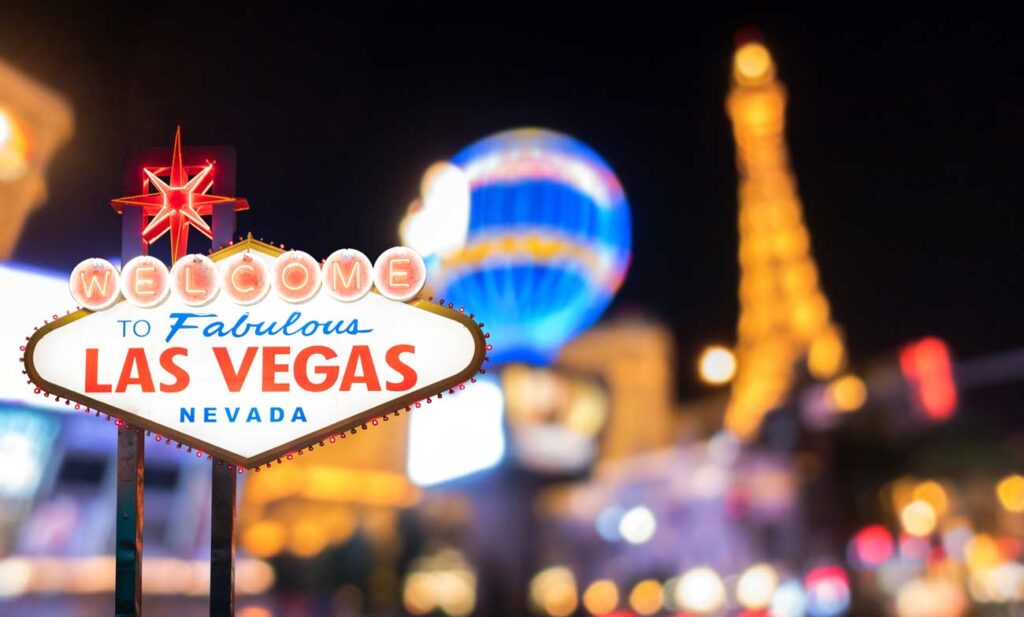Early Beginnings
The Las Vegas Valley has been inhabited for thousands of years, with evidence of nomadic Paleo-Indians dating back approximately 10,000 years. These early inhabitants left behind petroglyphs, marking the area’s ancient human presence. Subsequent Indigenous groups, including the Ancestral Puebloans and Paiutes, also called this region home.

In 1829, Mexican scout Rafael Rivera became the first non-Native American to traverse the valley. He named the area “Las Vegas,” Spanish for “The Meadows,” due to its abundant artesian wells and green landscapes. By 1844, explorer John C. Frémont’s writings about the area attracted pioneers, leading to the establishment of the Old Spanish Trail. The remnants of the Old Mormon Fort, built in 1855, still stand today as a testament to these early settlements.
Railroad Era and City Founding
The early 20th century marked significant growth for Las Vegas. In 1905, 110 acres of land adjacent to the Union Pacific Railroad tracks were auctioned, laying the foundation for the city’s downtown area. By 1911, Las Vegas was officially incorporated as a city.
The Impact of Hoover Dam
The 1930s brought transformative developments. The construction of the Hoover Dam, beginning in 1931, attracted thousands of workers, boosting the local economy during the Great Depression. The dam’s completion in 1936 provided the region with a reliable water source and hydroelectric power, facilitating further growth.

The Rise of the Strip and Gaming Industry
In 1931, Nevada legalized gambling, setting the stage for Las Vegas’s future as a gaming capital. The El Rancho Vegas resort opened in 1941 on what would become the Las Vegas Strip, introducing the concept of lavish hotel-casinos. The post-World War II era saw the rise of organized crime figures investing in casinos, with establishments like the Flamingo Hotel opening in 1946. This period also featured performances by the Rat Pack, solidifying Las Vegas’s reputation for top-tier entertainment.

The Mob’s Influence on Las Vegas
In the 1940s, organized crime figures recognized the potential of Nevada’s legalized gambling. Notably, Benjamin “Bugsy” Siegel played a pivotal role in developing the Flamingo Hotel in 1946, aiming to create a luxurious resort that attracted high-end clientele. This venture set the precedent for future developments on the Las Vegas Strip.
Throughout the 1950s and 1960s, mob involvement in Las Vegas expanded, with crime families from cities like Chicago and New York investing in various casinos. These establishments often served as fronts for money laundering and other illicit activities. The influence of organized crime during this era was significant, shaping much of the city’s early growth and reputation.
Transition to Corporate Ownership
The late 1960s marked a turning point as corporate entities began purchasing casinos, gradually diminishing mob control. The Nevada Corporate Gaming Act of 1969 facilitated this transition by allowing publicly traded corporations to own and operate casinos. This shift led to increased investments, the development of mega-resorts, and a focus on family-friendly entertainment, broadening Las Vegas’s appeal.

Modern Tourism in Las Vegas
Today, Las Vegas stands as a premier tourist destination, attracting millions annually. In 2023, the city welcomed approximately 40.83 million visitors, reflecting a robust recovery from previous years.
The city’s tourism industry significantly contributes to its economy, with visitor spending reaching substantial figures. Las Vegas offers a diverse array of attractions, including world-class entertainment, dining, shopping, and gaming experiences, catering to a wide range of preferences.
Preserving the Legacy
To understand and appreciate this complex history, visitors can explore institutions like The Mob Museum, officially known as the National Museum of Organized Crime and Law Enforcement. Located in downtown Las Vegas, the museum provides an in-depth look at the city’s past, showcasing artifacts and stories from the mob era.
The Golden Age of Entertainment
The 1950s and 1960s marked a pivotal era for Las Vegas, establishing its reputation as the “Entertainment Capital of the World.” During this time, luxury hotels began investing heavily in entertainment, leading to the birth of the famous Vegas show. Iconic performers such as Frank Sinatra, Dean Martin, and Sammy Davis Jr., collectively known as the Rat Pack, became synonymous with the city’s nightlife, drawing audiences from around the globe.
Evolution of Dining
Originally known for its cowboy town roots, Las Vegas has evolved into a premier dining destination with a diverse culinary scene. The city boasts over 40 celebrity chefs, offering a variety of high-end dining experiences. Notable establishments include Nobu Matsuhisa’s sushi, Le Cirque’s French cuisine, Wolfgang Puck’s Caramá, and José Andrés’ Bazaar Mar. Beyond luxury, Las Vegas offers budget-friendly options like the Peppermill and Tacos El Gordo, catering to a wide range of tastes and budgets.

Contemporary Entertainment and Dining
Today, Las Vegas continues to innovate, offering extravagant dinner and show productions that combine fine dining with live entertainment. Venues like Superfrico at The Cosmopolitan of Las Vegas provide an interactive dining experience where performers engage with guests, creating a unique fusion of cuisine and spectacle.
Top Bar & Restaurant: A Culinary Gem
Amidst the city’s dynamic culinary landscape, Top Bar & Restaurant stands out by bringing a diverse array of European and Mediterranean flavors to Las Vegas. Offering a unique dining experience that satisfies all tastes, the restaurant blends the rich flavors of Croatian, Italian, Mediterranean, and Eastern European cuisines. Whether you’re craving a classic Italian pasta, a Mediterranean seafood dish, an Eastern European delight, or a Croatian specialty, Top Bar & Restaurant’s menu has something for everyone.

Located conveniently near the Las Vegas Strip, Top Bar & Restaurant is the perfect spot to unwind after exploring the city’s vibrant attractions. Join us!
